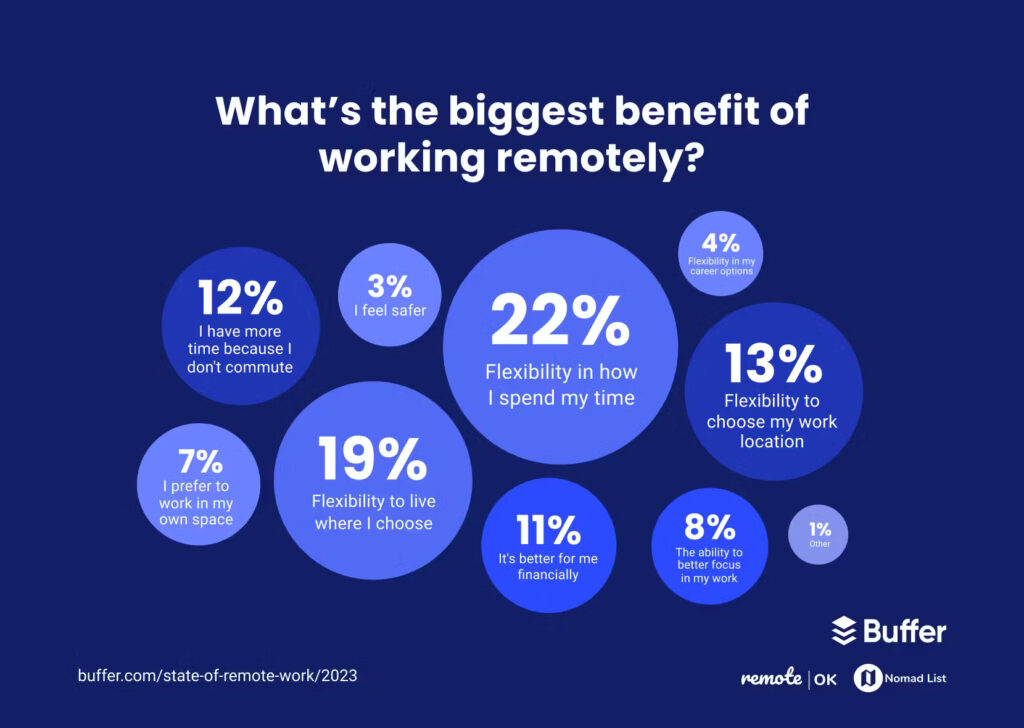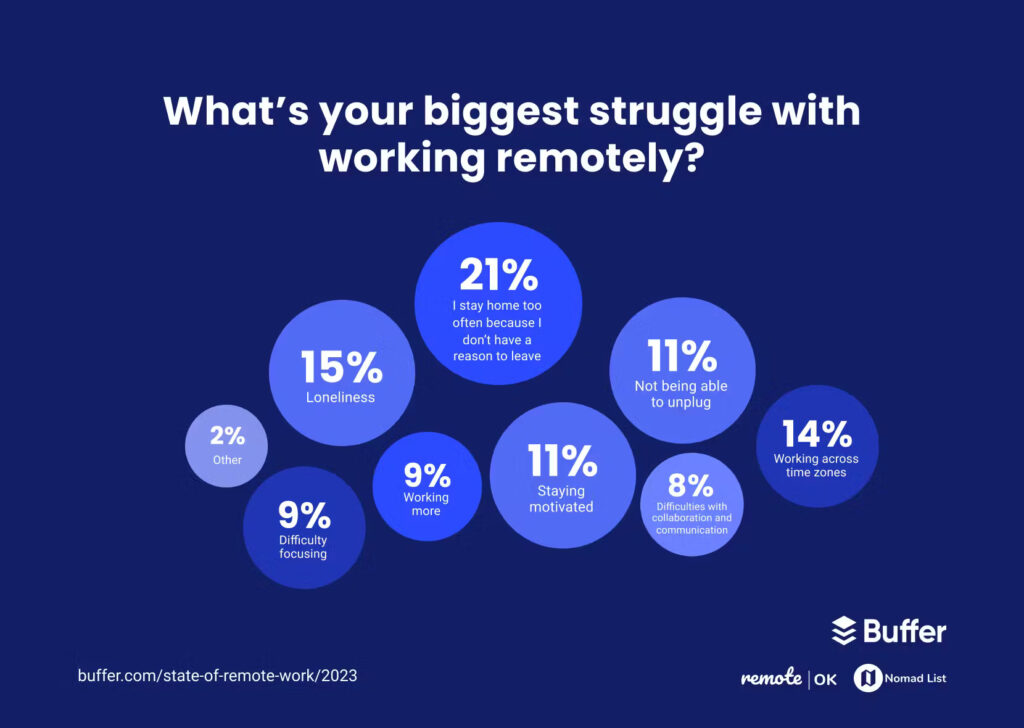Top 9 Hacks for Managing Remote Development Teams

Remote work is no longer the “new normal”; it has simply become normal. It’s a growing trend among developers who value flexibility in their work. According to a report, 98% of respondents expressed a desire to work remotely at least part of the time. Clearly, remote work is here to stay.
Why is remote work so appealing?

Credits: Buffer
The primary reasons include:
- Flexibility: Employees can choose where and when they work.
- Family Time: More opportunities to spend time with loved ones.
- Passion Projects: The ability to balance work with personal interests.
- Financial Benefits: Reduced commuting and other expenses.
From a company’s perspective, remote work offers significant advantages:
- Cost Savings: Reduced expenses for office space, utilities, and amenities.
- Access to a Larger Talent Pool: The ability to hire the best talent.
Challenges of Managing Remote Development Teams

Credits: Buffer
Despite its benefits, managing remote development teams comes with its own set of challenges. Ensuring that remote employees stay engaged, productive, and connected is not without difficulties. Some common issues include:
- Social Isolation: Employees may feel disconnected from their colleagues.
- Difficulty Unplugging: The lines between work and personal life can blur.
- Time Zone Differences: It is difficult to coordinate work across different time zones.
- Loneliness: Remote work can sometimes be isolating.
Is it possible to effectively manage remote development teams? Absolutely. Our offshoring service provider has consistently succeeded in keeping both our remote teams and clients satisfied.
9 Hacks for Managing Remote Development Teams – HCode
Here are nine strategies we’ve developed from years of experience to manage remote development teams effectively:
Hack 1 – Maintain Perpetual Communication
Facetime communication is the most critical part of handling a remote team. We specifically say face time because sometimes words don’t justify the meaning behind them. The facial expression conveys much more than words and creates a connection with the remote employee.
Seamless connectivity is difficult to manage with drags in time zones but is a must. Having a call every day solves many problems, it blooms a feeling in the person that they are a part of the team, just working from far away. The meeting also helps in setting clear goals beforehand so that the person doesn’t feel adrift or directionless until the next catch-up.
Furthermore, if done right, companies can benefit from the gap in the time zones to make their services available 24/7. Having a remote development team can make it an always-available team. Especially for developers, who are generally night owls, working at odd hours if preferable. The point is to embrace flexibility rather than being uptight because there is the world headed to.
Hack 2 – Set Reasonable Expectations or Goals
One reason why people opt out of remote work is due to being overburdened with unrealistic goals. The mindset of “They are at home, they don’t need to commute or anything, they can put in a few extra hours” is flawed. It’s essential to remember that remote employees choose this mode of work for flexibility and work-life balance. Burdening them with excessive work is akin to giving children holiday homework, which is widely recognized as counterproductive.
Instead, set reasonable expectations and provide milestones along the way. Focus on how the project can be completed in the long term. Day-to-day tedious tasks should not hinder your long-term relationship with your employees.
Hack 3 – Track outcomes, not activities
Companies generally have a norm of tracking their employees’ activities, especially in the IT sector, where employees are often glued to their desks. A common mistake companies make when adopting remote work is enforcing strict deadlines that are impractical for the remote workspace.
The reason we mention this is that, at home, people naturally align with their domestic habits and routines. Having lunch with family, attending to guests, and other unavoidable activities are part of this environment. Tracking remote employees’ activities and constantly checking on their work time often proves counterproductive.
A better approach is to measure outcomes. Evaluate employees’ performance based on their deliverables. As discussed earlier, setting realistic expectations is crucial. By assessing the remote development team’s productivity against these targets, companies can more effectively gauge performance.
Hack 4 – Utilize Collaboration Tools and Technology
Using the right collaboration tools and technology is essential for managing a remote software development team. Take Slack, for example. If you need to quickly have a discussion with your team, the huddle feature is there for you. If a chat is sufficient, that works too.
Project management software like Jira, Trello, and Asana helps keep track of tasks, deadlines, and progress. Communication tools such as Slack, Microsoft Teams, and Zoom facilitate real-time communication and help bridge the gap caused by physical distance. Ensuring all team members are proficient with these tools can enhance collaboration and productivity.
Hack 5 – Foster Inclusivity
Inclusivity is a critical component of remote team management. Remote employees should feel just as much a part of the team as those working on-site. Regularly scheduled virtual team meetings, social events, and one-on-one check-ins can help maintain this inclusivity. Celebrating milestones and achievements, no matter how small, also fosters a sense of belonging.
Creating an inclusive environment means being mindful of different cultures, backgrounds, and working styles. To achieve this, start with the small details. For example, refrain from referring to the remote team as “they” or “them.” Using “we” or “us” is a better way to address your distant peers.
Encourage team members to share their ideas and perspectives, and ensure that everyone has a voice during meetings. This can be achieved through structured agendas and rotating the meeting leader role. Inclusivity leads to higher employee satisfaction and retention, as team members feel valued and respected.
Hack 6 – Provide Perks for Office Set-Up
Supporting remote employees with their home office setup can greatly enhance their productivity and job satisfaction. Offering stipends for office furniture, high-speed internet, or ergonomic equipment demonstrates that the company values its comfort and efficiency. These perks can make a significant difference in the quality of work produced by a remote development team.
Moreover, providing these perks shows employees that the company is invested in their well-being. A well-equipped home office can reduce physical strain and improve focus, leading to better overall performance. Additionally, consider offering virtual workshops on ergonomics and productivity tips to help employees optimize their workspaces.
Hack 7 – Prepare Training and Sessions
Continuous learning and development are vital for keeping a remote software development team updated with the latest technologies and methodologies. Regular training sessions, workshops, and webinars can help in skill enhancement and knowledge sharing. Encouraging team members to attend industry conferences and online courses can also contribute to their professional growth.
Investing in training not only enhances individual capabilities but also drives innovation within the team. By staying current with industry trends, remote teams can implement cutting-edge solutions and maintain a competitive edge. Moreover, offering career development opportunities can boost morale and demonstrate the company’s commitment to employee growth.
Hack 8 – Encourage Feedback and Support
Creating an environment where feedback is encouraged and valued is crucial for the success of a remote team. Regularly seeking input from team members about what is working and what isn’t can help identify areas for improvement. Additionally, providing support through mentoring, coaching, and counseling can help address any personal or professional challenges that remote employees may face.
Open communication channels, such as anonymous feedback forms or regular check-ins, can help employees feel heard and supported. Constructive feedback should be specific, actionable, and delivered in a timely manner. When employees feel their concerns are taken seriously and addressed promptly, it fosters a culture of trust and continuous improvement.
Hack 9 – Employ Engagement Activities
Keeping a remote development team engaged is essential for maintaining morale and productivity. Virtual team-building activities, online games, and informal chat channels can help break the monotony and foster camaraderie. Organizing virtual coffee breaks or happy hours can provide much-needed social interaction and help build stronger relationships within the team.
By implementing these hacks, companies can effectively manage their remote development teams, ensuring high productivity, engagement, and job satisfaction. Embracing remote work and adapting to its unique challenges can lead to a more flexible, efficient, and successful team.
